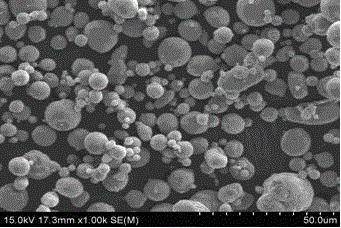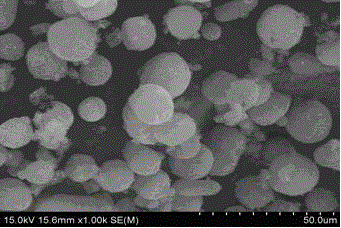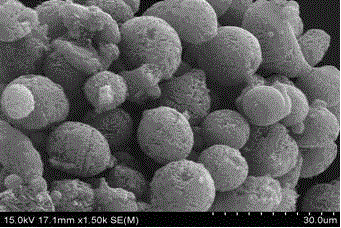Porous silicon/graphite composite electrode material with low expansion rate and preparation method thereof
A low expansion rate, composite electrode technology, applied in battery electrodes, batteries, circuits, etc., can solve the problems of increasing material cost, electrode expansion, volume expansion, etc., and achieve the effect of increasing capacity, improving conductivity, and low expansion rate
- Summary
- Abstract
- Description
- Claims
- Application Information
AI Technical Summary
Problems solved by technology
Method used
Image
Examples
Embodiment 1
[0053] (1) Preparation of alloy silicon spheres
[0054] Set the silicon content to 20% (such as figure 1 Shown) the aluminum-silicon alloy is sprayed, and the alloy ball with a diameter of 5 microns is obtained by controlling the ratio of the air flow and the material in the spraying process.
[0055] (2) Dealloying of alloy balls
[0056] Put the alloy balls obtained in step (1) into hydrochloric acid with a concentration of 1mol / L, and after corroding for 5 hours, filter the obtained solution, and dry the obtained powder to obtain porous silicon balls (such as figure 2 shown).
[0057] (3) Carbon coating of porous silicon spheres and mixing with graphite
[0058] Put the silicon spheres obtained in step (2) into CVD, pass through argon to evacuate, pass through methane and carbon dioxide to heat to 900 degrees Celsius, keep warm for ten minutes, and cool to room temperature to obtain graphene-coated porous silicon (such as image 3 Shown), porous silicon and graphite a...
Embodiment 2
[0060] (1) Preparation of alloy silicon spheres
[0061] Spray a magnesium-silicon alloy with a silicon content of 20%, and obtain alloy balls with a diameter of 10 microns by controlling the ratio of the air flow to the material during the spraying process.
[0062] (2) Dealloying of alloy balls
[0063] Put the alloy balls obtained in step (1) into sulfuric acid with a concentration of 5 mol / L, corrode for 10 hours, filter the obtained solution, and dry the obtained powder to obtain porous silicon balls.
[0064] (3) Carbon coating of silicon spheres and mixing with graphite
[0065] Put the silicon spheres obtained in step (2) into the sucrose solution, stir and mix thoroughly, then spray-dry the obtained solution, and carbonize the obtained sample under the protection of argon, the carbonization temperature is 500 degrees Celsius, and the time is 6 hours . The obtained amorphous carbon-coated porous silicon (such as Figure 4 shown) and graphite were added into the aqu...
Embodiment 3
[0067] (1) Preparation of alloy silicon spheres
[0068] The magnesium-silicon alloy with a component content of 5:95 is sprayed, and alloy balls with a diameter of 400 nanometers are obtained by controlling the ratio of air flow and material during the spraying process.
[0069] (2) Dealloying of alloy balls
[0070] Put the alloy balls obtained in step (1) into hydrochloric acid with a concentration of 1mol / L, corrode for 5 hours, filter the obtained solution, and dry the obtained powder to obtain porous silicon balls.
[0071] (3) Carbon coating of silicon spheres and mixing with graphite
[0072] The porous silicon and graphite obtained in step (2) are added to a low-speed ball mill in a weight ratio of 5:95 for thorough mixing (such as Figure 6 shown).
PUM
| Property | Measurement | Unit |
|---|---|---|
| particle diameter | aaaaa | aaaaa |
| particle diameter | aaaaa | aaaaa |
Abstract
Description
Claims
Application Information
 Login to View More
Login to View More - R&D
- Intellectual Property
- Life Sciences
- Materials
- Tech Scout
- Unparalleled Data Quality
- Higher Quality Content
- 60% Fewer Hallucinations
Browse by: Latest US Patents, China's latest patents, Technical Efficacy Thesaurus, Application Domain, Technology Topic, Popular Technical Reports.
© 2025 PatSnap. All rights reserved.Legal|Privacy policy|Modern Slavery Act Transparency Statement|Sitemap|About US| Contact US: help@patsnap.com



